St. Charles Steel Kitchen Cabinets: A Look at Their Line Circa 1950’s
The story of St. Charles steel kitchen cabinets begins in the early 1930s. Founded by Julius and Walter Roth, the St. Charles Manufacturing Company set out to revolutionize kitchen design. They sought to create kitchen cabinets that were not only beautiful but also practical, efficient, and durable. Their vision aligned perfectly with the principles of MCM design that were taking shape during the mid-20th century.
One of the defining characteristics of St. Charles steel kitchen cabinets was their pioneering use of steel. At a time when traditional wooden cabinets were the norm, St. Charles introduced the concept of sleek and streamlined steel cabinets. This innovation was met with enthusiasm, as it perfectly complemented the MCM movement's emphasis on futuristic materials and geometric forms.
St. Charles didn't just stop at using steel; they also prioritized functionality. Their cabinets featured efficient storage solutions, easy-to-clean surfaces, and a modular design that allowed homeowners to customize their kitchen spaces. The cabinets weren't just practical; they were a design statement in their own right, embodying the minimalist, utilitarian ethos of MCM design.
As the 1950s and 1960s rolled in, St. Charles steel kitchen cabinets gained immense popularity. They became a staple in mid-century homes, coveted for their durability and stylish aesthetics. The cabinets' adaptability made them a natural choice for homeowners looking to embrace the changing trends of the time.
The 1957 St. Charles Kitchen Cabinet Line
The 1957 St. Charles Kitchen Cabinet Line was a defining moment in MCM design history. It perfectly encapsulated the spirit of the era with its innovative use of materials, sleek lines, and functional elegance. These cabinets were more than just storage solutions; they were a statement of modern living.
One of the standout features of the 1957 St. Charles cabinets was their pioneering use of steel. At a time when wooden cabinets dominated the market, St. Charles dared to be different. The decision to use steel not only set them apart but also aligned perfectly with the MCM movement's obsession with futuristic materials and clean lines.
While the 1957 St. Charles cabinets were undoubtedly aesthetically pleasing, they were also incredibly functional. The modular design allowed homeowners to customize their kitchen spaces, making the most of every inch. Efficient storage solutions, easy-to-clean surfaces, and thoughtful detailing elevated these cabinets beyond mere furniture; they were a testament to the marriage of form and function.
Unveiled in 1957, the St. Charles Kitchen Cabinet Line was an instant hit. It appealed to homeowners who wanted a kitchen that was not only efficient but also stylish. The clean, uncluttered lines of these cabinets were a breath of fresh air, a stark departure from the ornate and heavy designs of the past.
The 1957 St. Charles cabinets embodied the core principles of Mid-Century Modern design. They were minimalist, with simple hardware and clean surfaces. They were utilitarian, emphasizing efficiency and ease of use. They were futuristic, thanks to the innovative use of steel. These cabinets weren't just functional; they were design statements.
Today, the legacy of the 1957 St. Charles Kitchen Cabinet Line endures. While many MCM design elements have evolved over time, these cabinets remain as iconic as ever. Homeowners with a passion for mid-century design often seek out these vintage treasures for their restoration projects, recognizing their historical significance and enduring beauty.
The Restoration of St. Charles Steel Cabinets
For those fortunate enough to own vintage St. Charles steel cabinets, the restoration process is a labor of love. It's about breathing new life into these timeless pieces while preserving their historical significance. Here's how it's done:
Cleaning and Stripping: The restoration process typically begins with a thorough cleaning and stripping of any old paint or finishes. This step helps reveal the original steel surface, which is often in excellent condition.
Repainting: Once stripped, the cabinets are repainted in the original colors or custom hues that match the homeowner's vision. This is where you can get creative while staying true to the MCM aesthetic.
Replacing Hardware: Over the years, hardware may have worn out or gone missing. Restorers often replace hardware with period-accurate pieces to maintain authenticity.
Refinishing Surfaces: The steel surfaces of the cabinets may be refinished to restore their shine and protect them from corrosion. Some enthusiasts even embrace the natural patina that develops with age.
Customizing Interiors: The modular design of St. Charles cabinets allows for interior customization. Restorers can adapt the cabinets to modern kitchen needs while maintaining the overall MCM look.
St. Charles Cabinets in Modern Kitchens
One of the remarkable qualities of St. Charles cabinets is their timeless aesthetic. While they are vintage pieces that harken back to the mid-20th century, their design has proven to be ageless. Their minimalist profiles and understated hardware seamlessly integrate with contemporary kitchen layouts, providing a touch of nostalgia without feeling out of place.
St. Charles cabinets were known for their durability, and this quality has stood the test of time. Many original cabinets, when properly cared for, remain in excellent condition even after decades of use. For homeowners seeking both style and longevity in their kitchen investments, St. Charles cabinets offer the best of both worlds.
While preserving the original MCM design elements, St. Charles cabinets can be customized to suit the specific needs of modern kitchens. Interior organizers, pull-out shelves, and other modern conveniences can be seamlessly integrated into the cabinet systems. This flexibility allows homeowners to enjoy the best of both worlds: vintage aesthetics and contemporary functionality.
In essence, St. Charles cabinets in modern kitchens serve as a bridge between the past and the present. They evoke the nostalgia of a bygone era while delivering the functionality and efficiency required for contemporary living. It's a design choice that pays homage to the enduring appeal of Mid-Century Modern design, proving that great design truly stands the test of time.
The resurgence of St. Charles cabinets in modern kitchens highlights the lasting impact of Mid-Century Modern design on the world of interior aesthetics. These cabinets seamlessly blend vintage charm with contemporary functionality, offering homeowners a unique opportunity to embrace the timeless beauty of MCM design. Whether sourced as vintage pieces or faithfully replicated, St. Charles cabinets are making a remarkable comeback, reminding us that good design never truly goes out of style.
About the Authors
Jamie and Lyle, MCM enthusiasts at Plaidsmith.com, offer hands-on experience and expert insights into mid-century modern design. They curate authentic pieces, share historical context, and guide clients to make informed choices. Their expertise spans iconic designers, restoration techniques, and trends. Trusted authorities in the field continually expand their knowledge to stay at the forefront of MCM. Beyond work, they explore auctions, learn restoration techniques, and enjoy vintage catalogs, embodying their passion for mid-century modern design.





















